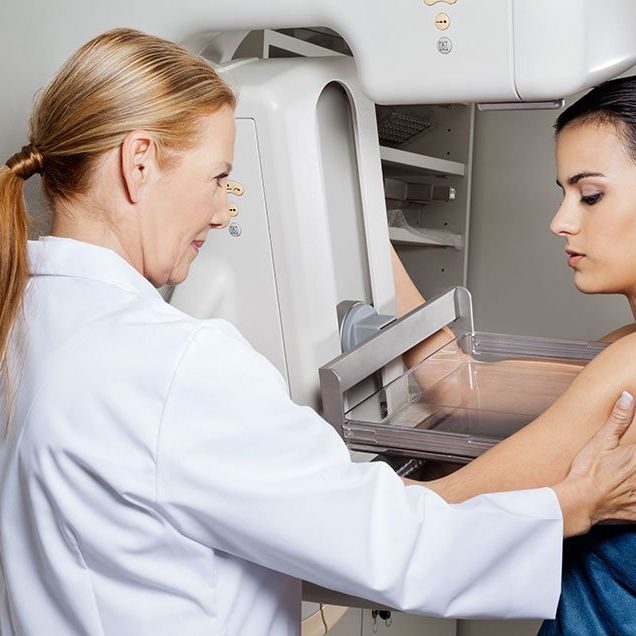This article was written by Hallie Levine and provided by our partners at Prevention.
Every year, almost 850,000 American women hear the terrifying words, "You have cancer." But all is not doom and gloom. While many people certainly get sick thanks to faulty genes and perhaps bad luck, research indicates that a whopping two-thirds of cancer deaths in the United States are preventable. Translation: There's a lot that you can control—provided you know what you're up against. We talked to some of the country's leading cancer experts to learn which types of cancer you ought to be most concerned about and how to protect yourself. Here, the top five cancers most likely to afflict women in the U.S. (Discover how to heal 95+ health conditions naturally with Eat for Extraordinary Health & Healing.)
5. Colon Cancer
Number of estimated new cases among women in 2016: 47,560
You may be surprised to learn that colon cancer is an equal opportunity offender, as the same number of women and men develop it each year, according to the American Cancer Society. "The good news is that it's almost entirely preventable," says David Greenwald, M.D., director of clinical gastroenterology and endoscopy at the Mount Sinai School of Medicine.
Protect yourself by: Getting screened regularly. The current gold standard is a colonoscopy, starting at age 50 and repeated every 10 years. During the test—which entails inserting a thin, flexible tube into the rectum—your doctor will get a good look at anything that might be amiss. "[A colonoscopy] not only diagnoses colon cancer, it also allows your doctor to detect and remove polyps before they could become cancerous," says Greenwald.
Other screening options include a fecal occult blood test, where your doctor checks your poop for blood that could indicate cancer, or a DNA stool test known as Cologuard, which looks for potentially cancerous gene changes. The downside of both, says Greenwald, is they can have false positives, which means you'd need to undergo a colonoscopy anyway.
RELATED: 7 Things Your Poop Says About You
4. Thyroid Cancer
Number of estimated new cases among women in 2016: 49,350
The chances of being diagnosed with thyroid cancer have more than doubled in the last 20 years, according to the American Cancer Society. But there's no need to panic. "We don't think the numbers themselves are actually increasing, but rather we're picking up more incidental cases when we do MRIs or CT scans for other reasons, such as to investigate recurrent migraines or neck pain," says Edmund Pribitkin, M.D., a thyroid cancer specialist at Thomas Jefferson University in Philadelphia. More proof: Even though incidence rates have skyrocketed, the death rates for this cancer have remained stable.
Protect yourself by: Not rushing into overtreatment. If your doctor detects a small nodule, the new thinking is to monitor it and not rush into surgery, says Pribitkin. And if you do end up needing surgery, getting just half of your thyroid removed (instead of the whole gland) may be an option. In that case, you might not even need to take thyroid replacement hormone, says Pribitkin. If your doctor pressures you to get your whole thyroid out—stat—despite having a nodule under one centimeter, get a second opinion. The operation does have risks (including damaging your vocal cords) and requires you to take thyroid hormone for the rest of your life.
RELATED: 16 Signs Your Thyroid Is Out Of Whack
3. Endometrial Cancer
Number of estimated new cases among women in 2016: 60,050
This type of cancer, also called uterine cancer, predominantly affects postmenopausal women (the average age of onset is 60). Alas, at this time there aren't any good screening tests to find this cancer early, says Cynthia Thomson, Ph.D., R.D., director of the Cancer Prevention and Control program at the University of Arizona Cancer Center.
Protect yourself by: Staying at a healthy weight. Endometrial cancer is twice as common in overweight women, and more than three times as common in obese women, according to the American Cancer Society. Fat cells secrete estrogen, which in turn can trigger cancerous changes, explains Thomson. If you're premenopausal and using birth control, consider taking the Pill, even for a few years: Just five years of use reduces endometrial cancer risk by 25 percent, according to a 2015 UK study published in the journal Lancet Oncology.
RELATED: 7 Surprising Things Your First Period Says About You
2. Lung Cancer
Number of estimated new cases among women in 2016: 106,470
Lung cancer cases among women have risen a jaw-dropping 98 percent over the last four decades, according to the American Lung Association. Even more shocking, more than half of the cases in women are among never smokers (read one woman's story here). Why is still a mystery; theories include women's lungs being more susceptible to secondhand smoke and estrogen possibly fueling cancerous cells, says Therese Bevers, M.D., a cancer prevention specialist at MD Anderson Cancer Center in Houston.
How to protect yourself: Don't smoke, and stay away from secondhand smoke, which can increase your risk of developing cancer by up to 30 percent. If you're a former smoker or have had a lot of exposure to secondhand smoke, ask your doctor if you should take one regular strength 325 mg aspirin daily; studies have shown that it might be protective, says Bevers.
1. Breast Cancer
Number of estimated new cases among women in 2016: 246,660
Technically, it's not the No. 1 type of cancer in women, as that title goes to skin cancer. But the American Cancer Society doesn't include non-melanoma skin cancers in its rankings, since they're rarely life-threatening. (In case you were wondering, about 8,500 people in the U.S. are diagnosed with any type of skin cancer every single day; an estimated 144,860 new cases of potentially deadly melanoma are predicted to crop up in men and women combined this year.)
Back to breast cancer, which one in eight women will develop in her lifetime. The good news is that, after rising for more than two decades, the number of women diagnosed with breast cancer began decreasing in 2000 and dropped by about seven percent from 2002 to 2003, possibly thanks to fewer women using hormone therapy for menopause symptoms. (Since then, incidence rates have been mostly stable.) What's more, breast cancer that's caught in the earliest stages now has a 5-year survival rate of nearly 100 percent.
How to protect yourself: Regular mammograms are crucial; ask your doctor when you should start getting them. The American Cancer Society recommends having this test annually beginning at age 45. Meanwhile, take a close look at your lifestyle habits. "Being sedentary, overweight, and consuming a high fat diet—particularly foods high in animal fat—all increase the risk of breast cancer," says Jame Abraham, M.D., director of the breast oncology program at Cleveland Clinic Cancer Center. Go easy on the booze, too: Regular alcohol consumption has been clearly linked with breast cancer, and research shows that the more you drink, the greater your risk.

Hallie Levine is a freelance writer who has written about health and fitness for more than 20 national publications, including Glamour, Newsweek, and the New York Post. She lives in in Fairfield, CT with her three kids and dog.













